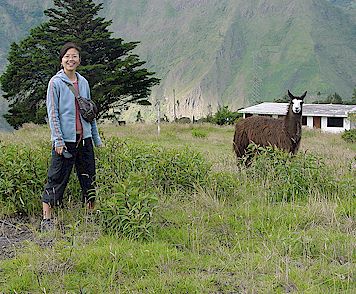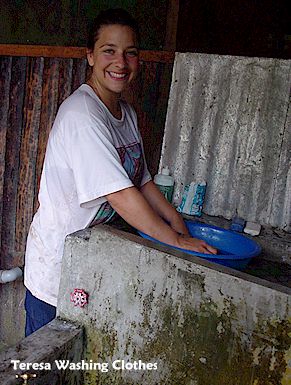Travel E-Logs: Amazon Rain Forest
Travel E-Logs #1: Introduction to the Project and the Adventure Team
Dear
students:
All aboard! Welcome to the Amazon Rain Forest School Project – and greetings
from Ecuador, South America! My name is Paul and I’m a teacher. My partners’
names are Lilia and Teresa. They are both teachers, too. The three of us will
be traveling with your class for the next six weeks to the Amazon Rain Forest!
So... ¡Bienvenidos y buen viaje!
Can you find Ecuador on the map? (If you are having trouble, here’s a clue: Ecuador means ‘equator’ in Spanish.) Can you locate the capital city, Quito? Do you see the Andes Mountains? They run up and down the whole west coast of South America. In the north, they tower over the Amazon which begins at their base to the east.
TRAVELING TO THE AMAZON
Of
course, you’ll be traveling to the Amazon with us from right inside
your own classroom, but Lilia, Teresa and I really will visit schools in the
rain forest. As we do, we’ll send you E-Travel Logs (like this one)
about our trip. We’ve also set up Internet adventures so you can visit
the places we visit, see the things we see and meet the students we work with.
Some of you will also be exchanging artwork, music, picture books or videos
with partner classes in the rain forest. That way, rain forest students will
learn about you from what you make and you will learn about them from what
they make. You can also ask questions of your partner class and we’ll
send you the answers. (What would you like to know about the rain forest?
What better way to find out the answers than to ask children who live there!)
ABOUT THE E-TRAVEL LOGS
In upcoming travel logs, we’ll tell you many things about the places we visit and the people we meet in the Amazon. For now, I’ll just fill you in on what the travel logs will contain and then tell a little more about us.
Guess
Who Animal Poems
Guess who! I like to write poetry, so I’ll also be sending
you some guess-who animal poems about mystery rain forest animals in some
of the travel logs. (One of my goals for the trip is to stump you with one
of my poems. Are you unstumpable?! Well, we’ll see about that. Better
study up on rain forest animals if you want to be able to guess all the poems.)
Spanish and Indigenous Mother Tongues
Since people speak Spanish in Ecuador, we’ll be including
some Spanish words and phrases in some of the E-mails we send you. ¿Hablas
español? Do you speak Spanish? ¿Estas estudiando español?
Are you studying Spanish?
Even if you don’t speak Spanish and are not learning it, you probably
already know lots of Spanish words. That’s because, many Spanish words
are similar to English words that mean the same thing. The word similar, for
example, is spelled the same in English and Spanish and means the same thing,
though the pronunciation is different. The same goes for animal.
Other words in Spanish only vary slightly from the English spelling, like
insecto or elefante. Others, like fresco, libro,
and arbol, are a little trickier to figure out, but have related
roots. Still others, like pared and aula, have no apparent
connection at all.
So, we’ll be including some Spanish words in the E-Travel Logs we send
you. Mostly, we’ll include Spanish words that are similar to their English
counterparts – and we’ll challenge you to figure out what they
mean in English. So, get your sleuthing caps ready!
Though Spanish is the official language of Ecuador (and most other South American
countries with the notable exception of Brazil, where Portuguese is the official
language), the indigenous peoples of the Amazon have their own languages,
or mother tongues. We will be visiting Quichua (Kichwa), Shuar
and Secoya villages in our travels; so we’ll also include a
few Quichua, Shuar and Secoya greetings and phrases in our E-travel
logs.
Flashbacks
I first lived and taught in the Amazon Rain Forest in 1994/95. Since then,
I’ve been back eight times and I’ve been directing the Amazon
Rain Forest School Project for the past five years. So, in this year’s
travel logs, I’ll also be including several flashbacks to previous years.
Photos
We’ll also be sending photos with our E-Travel Logs so
you can see some of the things we discuss in our reports. For now, we’re
just sending two photos (see below). The first shows Lilia with a llama in
the Andes Mountains. The second shows me near a waterfall called El Pailon
del Diablo (The Devil’s Pot) on one of the thousands of small Andes
Mountain rivers that feeds the Amazon River. We’ll send you a photo
of Teresa when she joins us.
ABOUT US
Here’s a little more information about our traveling
team of teachers and how we got to (or will get to) Ecuador...
My full name is Paul Hurteau. I’m a teacher from upstate
New York (near Canada). I have also lived and taught in Kenya, East Africa
and the Ecuadorian Amazon Rain Forest. Over the past five years, I’ve
visited schools in the Canadian Arctic, Namibia (Africa), the Galapagos Islands,
the Amazon and China to conduct projects like this one. I can speak Spanish
and, over the years, have also learned some Quichua, French, Luo, Swahili
and a little Chinese.
 Lilia
Cai is an English teacher from Shanghai, China. (Her Chinese name is Cai Li.)
Lilia has a degree in International Chinese Studies. She taught English as
a WorldTeach volunteer for a half a year in Quito, Ecuador and for another
half year in Limoncocha, one of the Amazon villages we’ll be visiting
during the project. She has worked as the Project Coordinator for OneWorld Classrooms since 2002, coordinating projects in Namibia, the Galapagos
Islands, the Amazon and China. She is fluent in Chinese, English and Spanish.
Lilia
Cai is an English teacher from Shanghai, China. (Her Chinese name is Cai Li.)
Lilia has a degree in International Chinese Studies. She taught English as
a WorldTeach volunteer for a half a year in Quito, Ecuador and for another
half year in Limoncocha, one of the Amazon villages we’ll be visiting
during the project. She has worked as the Project Coordinator for OneWorld Classrooms since 2002, coordinating projects in Namibia, the Galapagos
Islands, the Amazon and China. She is fluent in Chinese, English and Spanish.
Teresa Acevedo
Robinson is the project volunteer. She will be joining us in the Amazon around
January 15th. Teresa formerly worked for two years in El  Salvador
as a Peace Corps volunteer and has also taught English in a rural Chinese
village and worked with street children in San Paolo, Brazil. She speaks English,
Spanish and Portuguese fluently.
Salvador
as a Peace Corps volunteer and has also taught English in a rural Chinese
village and worked with street children in San Paolo, Brazil. She speaks English,
Spanish and Portuguese fluently.
To get to Ecuador, I flew from New York City to Guayaquil, Ecuador, then to Quito, the capital, high in the Andes Mountains. Lilia flew from Shanghai, China to Amsterdam in the Netherlands, to Bonaire, an island in the Dutch Caribbean, to Guayaquil, to Quito. Teresa will fly from San Paolo, Brazil to Quito. Can you trace our flights and estimate how many total miles the three of us will have flown to get here?
THAT’S ALL FOR NOW
We're
really looking forward to exploring the wonders of the rain forest with you
– and helping your class to interact with your partner class in the
Amazon.
We'll be in touch soon. IFeliz año nuevo!
Paul Hurteau
Project Director
Amazon Rain Forest School Project
=======================================
Teachers:
Visit the Amazon Rain Forest Classroom Package here
for related lesson ideas, reading material, fun activities and links to related
Web sites.
<><><><><><><><><><><><><><><><><><><><><><><><><><><><><><><><><><><>
| E-Travel Log #1: Introduction to the Project and the Adventure Team |
| E-Travel Log #2: Quito, Banos and Flashbacks of Christmas Celebrations in Limoncocha |
| E-Travel Log #3: Banos - Where the Rain Forest Begins |
| E-Travel Log #4: Limoncocha - A Quichua Community |
| E-Travel Log #5: Limoncocha and Communities Around - Traditions and Cultures |
| E-Travel Log #6: Getting Ready to Leave for Cuyabeno |
| E-Travel Log #7: Rain Forest Animals |
| E-Travel Log #8: Rain Forest Stories and the Mysterious Black Lake |
| E-Travel Log #9: Trip to Playas de Cuyabeno |
| E-Travel Log #10: Trip to San Pablo - a Secoya Community |
